How to choose the best gravel bike tires
Selecting the right tire for your gravel bike is an exciting, choose-your-own-adventure process. The huge variety of tire widths, tread patterns, and casings opens up a world of possibilities for gravel riders who have a knack for exploring unknown routes. Browsing gravel tires and geeking out about the appropriate rubber for your next ride is all part of the fun.
With so many options available, however, selecting the right tire for your gravel bike isn’t as straightforward as, say, road cycling, where tire specs tend to be more similar. This comprehensive guide walks you through finding the perfect tire that suits your bike and riding style. We dive into some of our favorite gravel bike tires that’ll get you back to grinding gravel and taming trails in no time.
After you've read the guide, shop all our gravel bike tires to find the perfect set for you.
Table of contents
Here's a basic summary of what the article covers. If you know exactly what part of the process you're interested in, you can click each section to jump the appropriate place on the page.
6. Our top gravel bike tire recommendations
8. FAQs
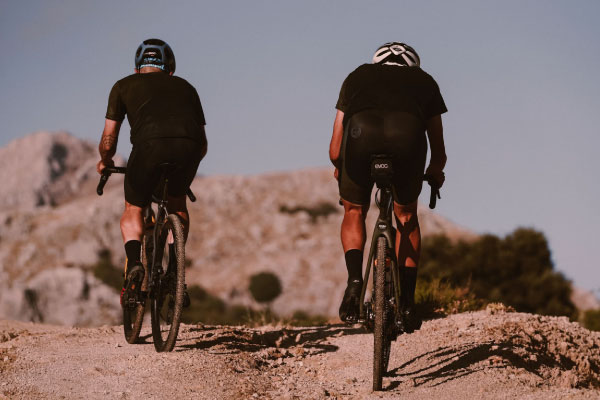
What should you look for in a gravel tire?
The perfect gravel tire checks all the boxes when it comes to tire width, tread pattern, and casing. These factors help optimize a tire for specific terrain, whether it’s light gravel, hardpack dirt, or chunky backcountry routes. Keep reading to learn more about the ins and outs of selecting the right gravel tire.
1. Gravel bike tire size
Gravel riders choose either 700c or 650b tires to match the wheel size they’re running. If your bike frame only accommodates one of those wheel sizes, this decision is already made for you. However, many modern gravel bikes work with either standard so riders can easily swap between wheelsets.
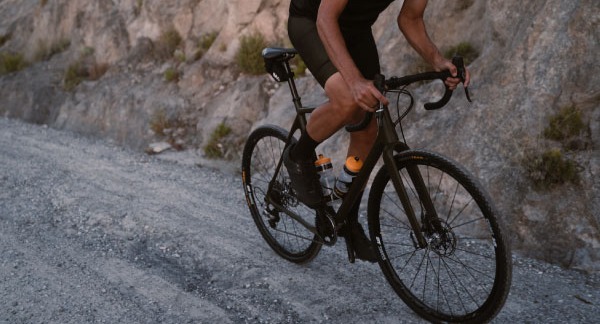
700c gravel bike tires
The most common gravel tire size is 700c and it’s also the same diameter as road bike tires. That said, gravel tires of this size will be significantly wider than your typical road tire. 700c gravel bike tires come in a variety of widths rated for all sorts of riding, making them a versatile and convenient choice. The best tire size for gravel bike riding will be 700c if you want a set of tires you can also use on a road bike (assuming there’s enough clearance) or easily swap to another gravel bike.
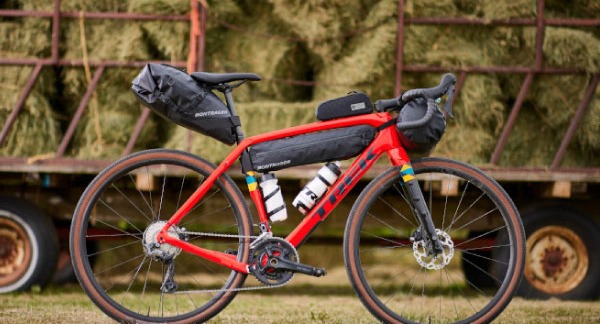
650b gravel bike tires
Because of its slightly smaller diameter, the 650b size generally lets riders fit wider tires inside the frame. The extra width and air volume allows for lower pressures and traction, which is especially useful on chunkier routes. Bikepacking enthusiasts and off-road riders often reach for this beefier tire size. Wide 650b gravel bike tires increase the overall diameter of the wheel, effectively bringing it quite close to the diameter of 700c tires.
2. Tubeless gravel bike tires
Tubeless tires have taken over as the preferred setup for cyclists who ride off pavement. Almost all bike tires for gravel are tubeless-ready so riders can easily make the swap from standard tires with inner tubes.
Tubeless tires reduce weight and can be run at lower pressures for more grip and cushion in rugged terrain. In case of a puncture, the tubeless sealant automatically stops the leak so you can keep on rolling without interruption. Riders can carry small tire plugs to repair a tire with a puncture too large to be effectively sealed by the sealant.
Still, some riders may reach for standard tubed tires when tools are limited and sealant refills aren’t an option. It can be a more straightforward fix to simply pop a new inner tube into the tire during remote expeditions or backcountry trips. In most situations, however, tubeless tires are what you’ll want to use.
3. Gravel bike tire width
Our recommendation is to simply choose the widest tire that your bike frame will accept. More often than not, the traction and comfort gains from wider rubber outweigh the gram savings from narrower gravel tires.
Narrow vs. wide tires
Going beyond 32mm wide means you’re entering gravel bike tire territory— most gravel bikes are designed to perform at their best with tires between 38-45mm wide. Some modern bikes even have clearance to run 50mm gravel tires.
The argument for narrower gravel bike tires is that the reduced rotational weight can help with climbing and accelerations. If you want a lightweight setup that still rolls fast on smoother terrain, the narrower 35-38mm range will be your sweet spot.
Tire width is a common talking point before gravel races and, in a game of mere millimeters, it can make a big difference for the pros who need to get these specs just right. For most riders, however, the comfort and traction from wide tires are more important than pure pace.
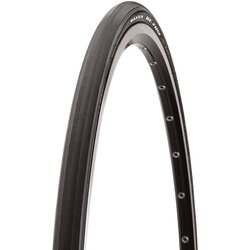
32-35mm gravel tires
Just beyond standard road bike tire widths, these skinny gravel tires are ideal for pavement riding with the occasional off-road detour. The narrow width keeps you rolling fast on asphalt surfaces and can still handle light gravel and smooth dirt roads.
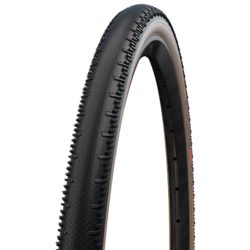
38-45mm gravel tires
This is the most common gravel tire width that’ll fit most gravel bike frames and perform well in a variety of terrain. If you are searching to boost comfort and reduce fatigue out on your rides, slap on some of these gravel tires between 38mm-45mm wide.
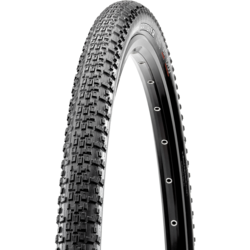
47-50mm gravel tires
These wider gravel tires are ideal for bikepacking, off-road touring and general riding where the trail surface is looser and chunkier. Wider tires can run lower pressures to help soak up bumps and reduce vibrations to the body. The larger contact patch means more confident handling in corners and singletrack.
4. Gravel bike tire tread
Tire tread is where you can truly customize your gravel setup based on the terrain. Tire manufacturers put their creativity on full display with tread patterns running the gamut from smooth slicks to dense knobs. Different treads have certain strengths and weaknesses so having the right match is key to getting the most out of your ride. Picking the wrong tread pattern won’t be the end of the world, but may limit grip in dicier conditions.
Slick tread
Slick gravel tires are essentially wider versions of road tires. The low-profile tread is ideal for riders who mainly stick to pavement, smooth dirt, and gravel roads. These tires are the fastest gravel bike tires on paved roads but aren’t necessarily the quickest on rougher terrain. The lack of raised knobs means reduced rolling resistance over smoother surfaces— perfect if you spend a lot of time on paved routes with the occasional gravel detour. These tires commonly have a slight file tread pattern for extra grip on light dirt paths. The slick texture means that there is more rubber in contact with the ground for better grip than knobby tires in drier, smoother conditions.
Semi-slick tread
A semi-slick tire has a slick center strip with raised knobs along the sides for added traction when cornering. The smooth or file-tread section in the middle lowers rolling resistance on paved surfaces so you can rest assured you’re not wasting watts. The extra texture on either side bites into looser terrain so you can have the best of both worlds. This tire type is great if you ride plenty of kilometers on paved surfaces but still want confidence when it’s time for loose dirt or gravel routes.
All-rounder tread
If you’re looking for a do-it-all gravel tire, this type is a sure bet. There’s a dual tread pattern like with semi-slicks, only the textures here are more aggressive. The central stripe is typically covered in low-profile, densely packed knobs with bigger side-knobs for cornering. This versatile tread pattern is a good compromise between semi-slicks and extreme gravel tires, allowing you to explore virtually any gravel route on the map while still being fast enough on paved sections. If you spend most of your time on loose gravel and dirt tracks— using paved roads sparingly— go for an all-rounder gravel tire.
Extreme/mud tread
These gravel tires have larger knobs to bite into trail surfaces and shed mud when needed. Aggressive gravel tires are a good idea for backcountry riding or bikepacking when trail capabilities are more important than efficiency on pavement. If you ride through rough gravel, mud, or some singletrack, these beefier gravel tires provide better traction and grip in the corners. The specific knob shapes are often specially designed to clear away muck buildup so riders maintain traction in sticky mud. Extreme gravel tires approach the characteristics of XC mountain bike tires.
5. Gravel bike tire casing
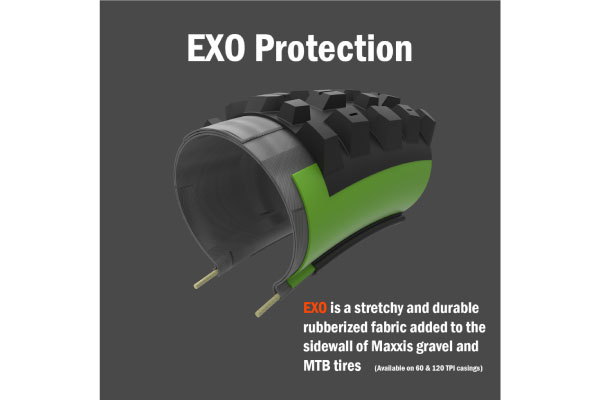
Gravel bike tire casing is all about finding the right balance between durability and performance. Tire casing refers to the woven layers of material that make up the actual tire which can be tuned to deliver certain ride qualities. Gravel tires are available in a variety of casing options, including lightweight, standard, and plus-rated tires with puncture protection.
Supple, lightweight casing
A high TPI (threads per inch) indicates a supple and comfortable tire, but it may not be as durable as other tires. The weight savings here can also help in races and increase efficiency on smoother roads. If you typically ride on lighter gravel with plenty of time on paved surfaces, you can get away with running a lightweight, super supple tire.
Standard casing
Durability is especially important in gravel biking where tires receive a constant beating from small rocks and jagged surfaces. Tire brands often make tires available in a range of casings with the standard model providing all-rounder performance that’s plenty durable with a comfortable ride feel. This casing sweet spot lets you ride tons of terrains without having to worry about swapping tires every time.
Casing with puncture protection
Many gravel tires come with an extra layer of puncture protection within the casing. The tough, puncture-resistant fabric reduces the chance of a flat when riding over especially chunky or sharp terrain. These tires will typically have the term “plus” in their name and do come with a weight penalty, often weighing around 30g to 60g more per tire. That trade-off is worth it if you frequently ride over sharp, rocky gravel or want to do your best to avoid flats during a race. For example, many participants in the famed Unbound gravel race in Kansas opt for plus-rated gravel tires to limit punctures over the course’s jagged flint rock surface.
Our top gravel bike tire recommendations
There are several gravel tires that have won over the team at Ridley’s Cycle. A great gravel tire is all about reliability so you can take on varied terrain with confidence, freeing you up to enjoy the adventure. We’ve selected a few of our favorite gravel tires to help you find the perfect set.

Best all around gravel bike tire
Maxxis Rambler
The Maxxis Rambler is a tubeless-ready tire built specifically for gravel and dirt road riding. The all-rounder tread pattern features tightly packed center knobs for faster performance on hardpack surfaces, along with spaced side-knobs for controlled cornering.
It’s a super versatile tire with a dual-compound construction for increased longevity. Riders can choose between the 60 TPI SilkShield model that’s more durable or the 120 TPI EXO version that’s lighter weight.
If you tend to consistently switch it up between rides on pavement, gravel, and dirt roads, the Rambler does it all well.
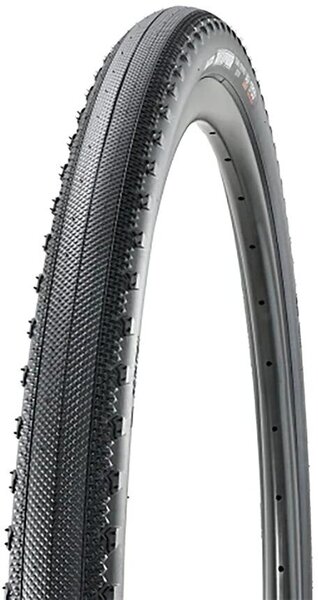
Best bike tire for gravel and pavement
Maxxis Receptor
The Maxxis Receptor is a semi-slick gravel tire that’s perfect for pavement, hardpack dirt, and gravel roads. The file-tread pattern in the center of the tire lowers rolling resistance over smooth surfaces while providing more grip than a standard slick tire. The raised knobs along the sides offer increased traction when cornering. The 120 TPI EXO casing is supple and lightweight so you can take on adventurous routes with pace. If your favorite gravel rides are relatively smooth with the occasional off-road detour, the Receptor is the best choice.
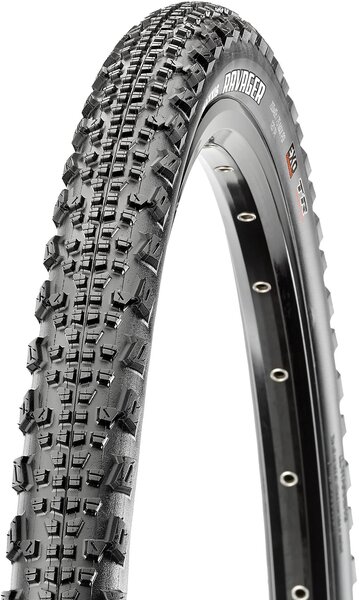
Best gravel bike tire for gravel and trails
Maxxis Ravager
The Maxxis Ravager turns up the heat with a more aggressive tread pattern designed for loose gravel and singletrack trails. This tubeless-ready tire has square-edged center knobs for optimal climbing and braking performance on dusty trails or chunky gravel. The larger side-knobs bite into the trail surface when cornering giving you that extra bit of control. This extreme gravel tire is perfect for off-road tours and muddy conditions where more intense gravel terrain is expected.
Gravel bike tire pressure
Tire pressure is an easily adjustable variable that can make a huge impact on gravel riding. Running the appropriate pressure allows you to get the most out of your chosen tire and, unlike purchasing a whole new set of rubber, altering your tire pressure is free!
Before we get into more detail, here's our recommendation for setting tire pressure on a gravel bike:
1. Set the pressure squarely in the middle of the tire's recommended range
2. Go for a ride! Make sure your test ride is representative of the terrain you'll be riding most often. Oh and bring a hand pump (and a pressure gauge if you have one).
3. If you're feeling too much chatter, air down a tad and continue until it feels smooth yet capable and fast.
4. If you feel sluggish on turns and pavement, air up a bit.
5. If you have a pressure gauge, note the sweet spot. If not, check when you get home.
Rider weight, surface type, and style of riding are all integral in choosing the perfect tire pressure, and all that is highly specific to you. Get out and experiment. As long as you're riding comfortably, confidently, and not flatting or damaging your rim, there's no wrong answer.
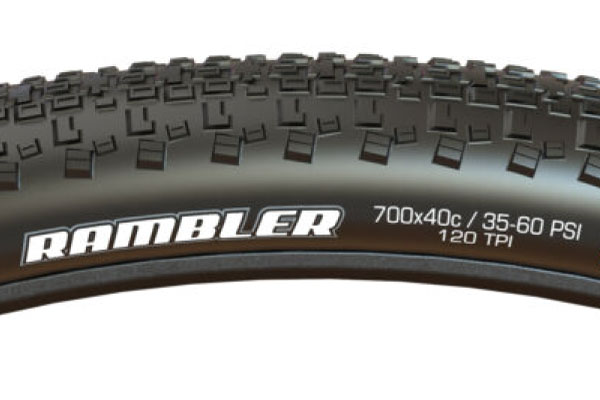
Gravel tires operate at much lower air pressures than road tires for a much more comfortable and grippy ride. The exact PSI you’ll want to run will depend on rider weight, tire width, and expected terrain, but gravel tire pressures typically range between 20 PSI to 45 PSI. Heavier riders or narrower tires will need higher pressures.
All tires have their recommended PSI range printed or embossed onto the sidewall, so be sure to check that before you inflate. Overinflating can lead to blowouts or damaging the rim, not to mention the harsh ride feel due to rockhard tires. Running too low a gravel bike tire PSI reduces efficiency and risks ‘burping’ the tire, when the tire bead separates from the rim and releases air.
Avoid the temptation of thinking that harder tires equate to a faster ride. That may be appropriate for road tires in some situations (although even that has been questioned), while the cushion offered by gravel tires helps you roll over rugged terrain with more control and comfort. Use a pump with an accurate gauge to ensure your achieving the ideal tire pressure for gravel bike riding.
Top gravel bike tire questions
Can you put gravel tires on a road bike?
Yes, assuming your road bike has sufficient clearance for the gravel tires. Modern road bikes— especially endurance models— have a bit more room for wider rubber these days, but may max out around 32mm or 35mm. Only 700c gravel tires will be compatible with road bikes.
Can you put gravel tires on a mountain bike?
650b gravel tires have the same diameter as 27.5” mountain bike tires, so they may be interchangeable. Most gravel tires are significantly narrower than mountain bike tires so you’ll have to confirm that the rim can accommodate the tire. For example, a wide 50mm gravel tire measures around 2.0” which is similar to a XC mountain bike tire.
How long do gravel bike tires last?
Gravel tires are expected to last up to around 4,000 kilometers, but tire wear will depend on the terrain you’re riding. If you frequently ride over sharp gravel or jagged surfaces, it’s a good idea to run tires with a more durable casing that’ll stand up to the heavy use.
Can road bike tires go on gravel?
Road bike tires can be taken on gravel routes, but you’ll experience significantly less traction and comfort. Riders can get away with road tires on dry, light gravel paths but those narrow and slick road tires will sink down in loose gravel.
How wide are gravel bike tires?
Gravel bike tires vary greatly in width from 35mm to 50mm. The looser and chunkier the terrain, the wider you’ll want to go. 38mm-45mm tires are a common choice for smoother surfaces like pavement, light gravel, or hardpack dirt.
